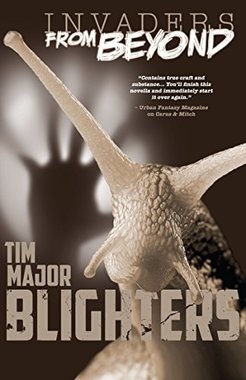|
John Wyndham performs a couple of sleights of hand in setting up the scenario of The Day of the Triffids. Firstly, he avoids the fiddly task of detailing the downfall of society. Bill Masen is one of the few people not to be blinded by the sight of a green comet shower – he ends his temporary blindness by removing his hospital bandages, only to find that the rest of the population is permanently blind. (Incidentally, this scene is my earliest memory of being terrified by a novel, for months after reading it.) Masen discovers a society already collapsed, with many of the blind suicidal or frantically looting food from abandoned shops. John Wyndham performs a couple of sleights of hand in setting up the scenario of The Day of the Triffids. Firstly, he avoids the fiddly task of detailing the downfall of society. Bill Masen is one of the few people not to be blinded by the sight of a green comet shower – he ends his temporary blindness by removing his hospital bandages, only to find that the rest of the population is permanently blind. (Incidentally, this scene is my earliest memory of being terrified by a novel, for months after reading it.) Masen discovers a society already collapsed, with many of the blind suicidal or frantically looting food from abandoned shops. Secondly, the triffids – strange carnivorous plants with unknown origins – have already dispersed around the world, several years before the catastrophe, and have become common enough to no longer concern society. The coincidence that humans’ sudden blindness is enough to allow the triffids to gain the upper hand is never explicitly linked to their arrival – instead, both the triffids and the green comet shower are vaguely linked to human experimentation within the Soviet Union. The fact is, it doesn’t matter. The protagonists of the novel will never know the truth, and knowing it wouldn’t change their fate. The Day of the Triffids is often cited as the first and archetypal ‘cosy catastrophe’ novel. I’m a huge fan of cosy catastrophes (I even named my website after the phrase) – I think a lack of immediate danger to the protagonists can allow a story to explore beyond physical threat, to something broader and, often, more interesting. Here’s what I love about The Day of the Triffids. Throughout most of the novel, the triffids present a persistent obstacle rather than a major threat. Wyndham uses them to illustrate the tenuous hold on power that the human race had before the disaster – for the most part, the novel is concerned with differing approaches to survival. Masen meets several groups of survivors, including a Christian group that insists that traditional gender roles and morals are preserved; a city gang allocating a single sighted person to lead each community of blind looters; a group who recognize that the human race can only be rebuilt via ‘free love’; a despotic government offering Masen a feudal lordship over a blind community. In short, it’s not a book about triffids, it’s a book about people’s reaction to threat. Those that are wiped out generally manage it through their greed and inability to adapt. Wyndham stresses the need for society’s moral code to reflect the circumstances and goes out of his way to detail Masen’s conflict about breaking taboos – for example, stealing from shops or sleeping with more than one woman. I read The Day of the Triffids when I was ten, thanks to a particularly garish Penguin cover that suggested that it was a natural stepping-stone from Doctor Who novelisations. It turned out to be the perfect gateway to catastrophe fiction and a wonderful illustration that ‘monster horror’ could be about people and the real world. Twenty-five years later, my novella, Blighters, is explicitly a homage to The Day of the Triffids, with its dormant alien threat, its sense that the invasion has already happened, and that humanity’s downfall will be due to its own blindness.  Them Blighters are everywhere. They fell out of the sky last year, great horrible armour-plated slugs with razor-sharp fangs. But ugly as they are, they give the ultimate high to anyone nearby: a blissful, gleeful contentment that people are willing to kill for. Not Becky Stone, though. All she wants is to drink beer, listen to her dad’s old vinyl, and get her life back to how it was before everything was all messed up. Blighters? Frankly, she could do without them. “Contains true craft and substance... You’ll finish this novella and immediately start it over again.” Urban Fantasy Magazine on Carus & Mitch PURCHASE A COPY FROM AMAZON UK / PURCHASE A COPY FROM AMAZON.COMComments are closed.
|



 RSS Feed
RSS Feed

